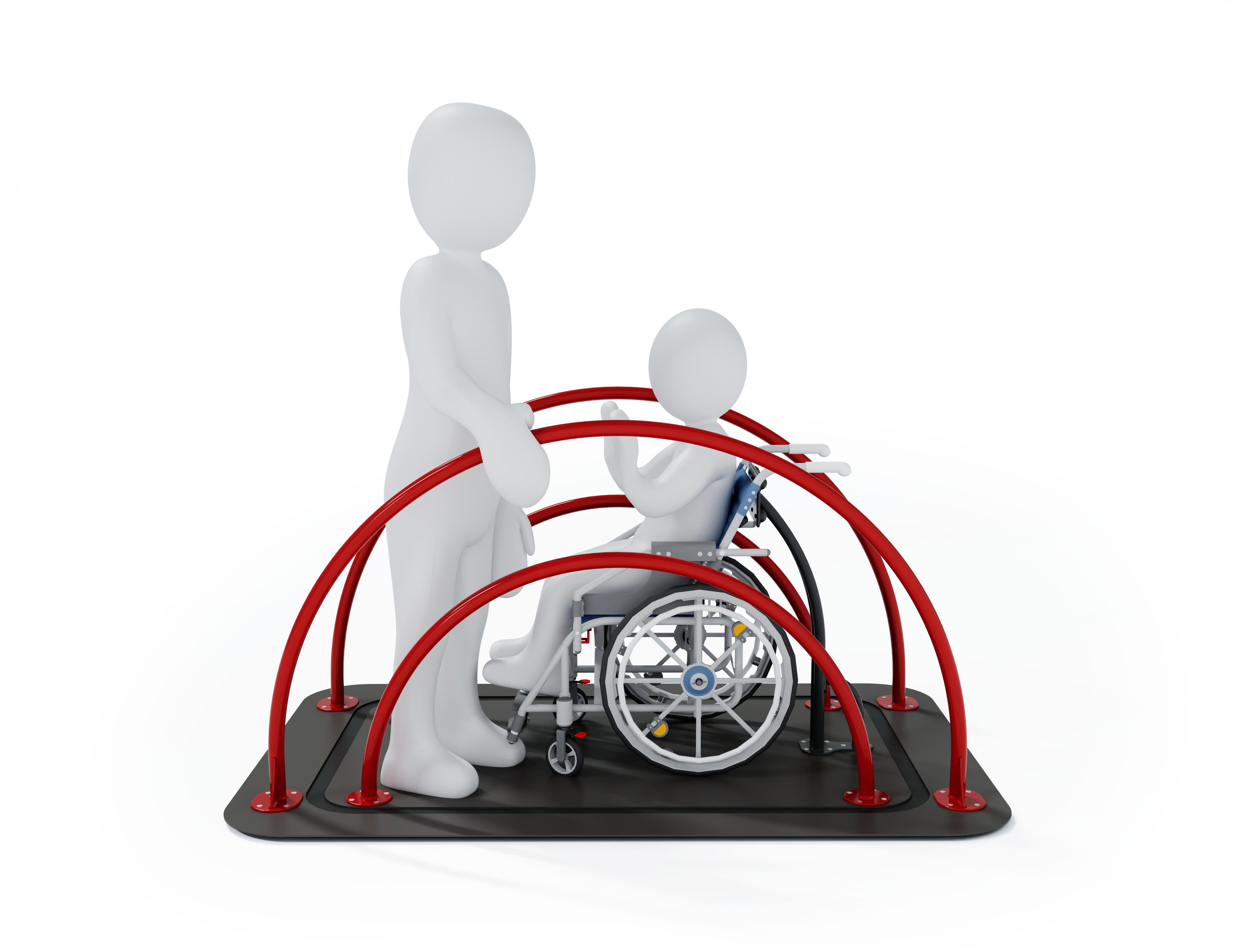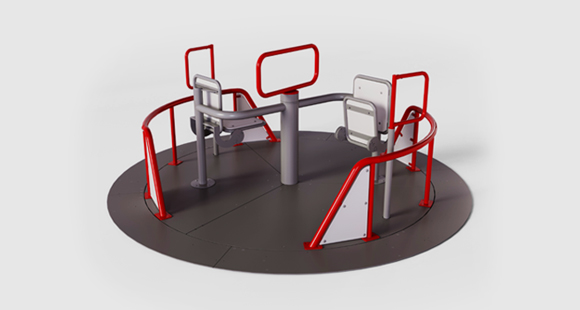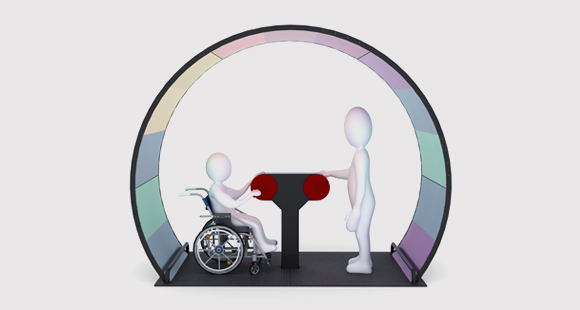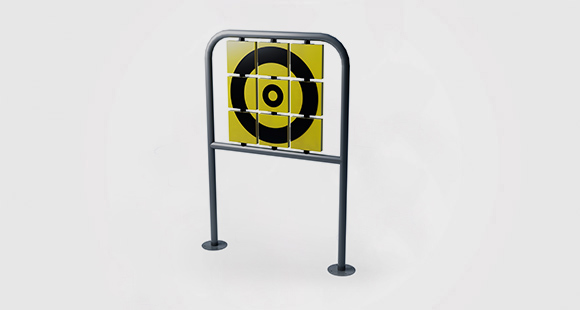Medical devices We design to help
ACCESIBLE PLAYGROUND DEVICE – HOW TO CHOOSE A RIGHT ONE?
Accessible, inclusive, integrative device, "barrier-free" - there are many terms used by manufacturers to designate playground devices that are intended for people with disabilities. How to know, which device actually meets accessibility requirements and which one has only been named so to expand the commercial offer?
The UN Convention on the Rights of the Child states that "All children with mental or physical disabilities should be provided with a full, normal life in conditions that guarantee their dignity and facilitate the child's active participation in the life of society. Children have the right to rest and free time, to participate in games and activities recreational activities”. (Articles 23 and 31 of the Convention). This provision means that virtually every newly constructed playground should be designed in a way that allows access to people with different levels of ability.
Designers wanting to meet this requirement of the convention and, at the same time, of the investor, reach for devices described in the marketing slogan as accessible, inclusive, integrative or "barrier-free", not always knowing whether their features actually mean that able-bodied people can play together with people with disabilities. disability.
If both seem to be accessible, why to pay more?
The problem with the selection of devices is also that, because there are no standards, designers do not know what criteria should be followed in order to include truly integrated and inclusive devices in the project. Often, the marketing description and price decide.
When comparing the offer of integration devices, it is easy to notice that they are slightly more expensive than solutions aimed only at able-bodied people. The city or commune office is aware that adding this type of device to the equipment may mean higher costs and often has good will to allocate funds for this.
However, when purchasing a truly inclusive device, it turns out that instead of a seemingly higher price, it is a saving! One set of devices serves both groups of users equally - both able-bodied and disabled people!
Unfortunately, devices intended only for one group of recipients are often selected, excluding the other - devices only for able-bodied people or devices only for people in wheelchairs, which is a big ideological and functional mistake, for which you unfortunately have to pay twice.
The result of a random selection of devices or the price criterion is the expenditure of funds on a pseudo-accessible playground which, despite good intentions, is still not accessible to people with disabilities and is even dangerous for all users, so the situation does not change despite the funds spent. The apparent action does not affect the ability of children with disabilities to have access to play. So we need to build another playground.
Wheelchairs accessible swings
One of the most popular devices for people with disabilities are gondola swings. Unfortunately, these devices are dedicated only to one group of users - people in wheelchairs. Manufacturers mark devices with an icon of a crossed out disabled person, which means that a disabled child cannot use the device. In practice, however, this ban is impossible to respect, and able-bodied children use gondola swings in a way that poses a threat to their health and life.
This type of device and the segregation of users clearly show that prohibitions do not matter, and playgrounds must be designed and equipped in an inclusive way, i.e. accessible and safe for all user groups, without exposing any of them to danger.
Playground sets
The most frequently chosen devices are large structures in the form of locks, offered as integration sets, which rarely have anything to do with actual integration. These are structures with ramps that theoretically can be used by people in wheelchairs. The only question is whether it is really fun, because these people have ramps practically everywhere in their everyday life - to school, to a rehabilitation facility, to the store. These ramps usually lead nowhere, because a person in a wheelchair cannot slide down the slide or go down the stairs. He can only watch other children play from a close distance. Educational boards are sometimes installed near driveways, but they could just as easily be placed at ground level, without the need to go up the driveway.
Assembling such a set is therefore an unnecessary expense that increases the value of the play set, while it would be enough to design several manipulation and educational boards in an interesting way, at an appropriate height so that all children could use them.

It is supposed to be inclusive - let's give "stork's nest"!
One of the most popular devices on "inclusive" playgrounds are stork's nest swings. Cheap, quick to install and described as integrative - they seem to be the perfect choice. Currently, in the face of accidents that occurred on gondola swings for people in wheelchairs, "stork nests" are treated as a safer alternative, but they are not an alternative, and a playground equipped only with such a swing cannot be called inclusive!
From the perspective of a parent of a child using a wheelchair, they are a device that is practically unusable. Firstly, they are usually mounted on sand as a shock-absorbing surface, which excludes the possibility of getting close to the device. The parent must stop with the child on a paved surface and, after taking the child out of the wheelchair, carry the child to the stork's nest. Once there, he usually worries about the stroller and personal items left a considerable distance away.
Children in wheelchairs often have trouble maintaining a sitting position on their own, so they are forced to swing while lying down. In such a situation, integration with other children is out of the question.
However, stork nest swings are indeed a great element of fun for a certain group of children and therefore it is not worth giving them up, but they should not be, next to traditional swings for able-bodied people, the only integration swing on the playground. They are great for walking children, e.g. with intellectual disabilities, autism spectrum disorder, Down syndrome, but they will certainly not be useful for children using wheelchairs.
Dangerous Seesaws
Weight swings with equal-length platforms placed on both sides of the axis are problematic in terms of integration, but also the safety of people in wheelchairs. They are intended to enable two people in wheelchairs to swing at the same time, but in practice, when one of them enters the platform, the other one, raised up, prevents the other wheelchair from entering. To activate the device in such a situation, the participation of people standing outside the device is also required, who will raise and lower the platforms. So it's not a standalone game.
Another safety aspect is the moment when the wheelchair leaves the platform and the participant leaves the opposite platform. This will cause the wheelchair and the user to tip backwards.
Therefore, you need to choose devices that have different platform lengths and protection against overturning the trolley even if the platform is accidentally lowered - an example is the solution presented below.

Not accesible ground trampolines
The use of ground trampolines, described as dedicated to people in wheelchairs, is an incorrect marketing term. Trampolines are a good solution for people who walk and are able to maintain body balance. For people in wheelchairs, they primarily pose a threat when entering the device, because they usually do not have handrails for protection, and the surface intended for jumping is significantly lower than the level of the surface on which the wheelchair rides. The fun itself is also risky - without the possibility of securing yourself, a person in a wheelchair, receiving the vibrations of the jumping platform, may simply fall over together with the wheelchair. Leaving the device is also problematic and dangerous.
Therefore, when choosing a rebound device, you must pay attention to the possibility of protection and real and safe use by people in wheelchairs and able-bodied people.






